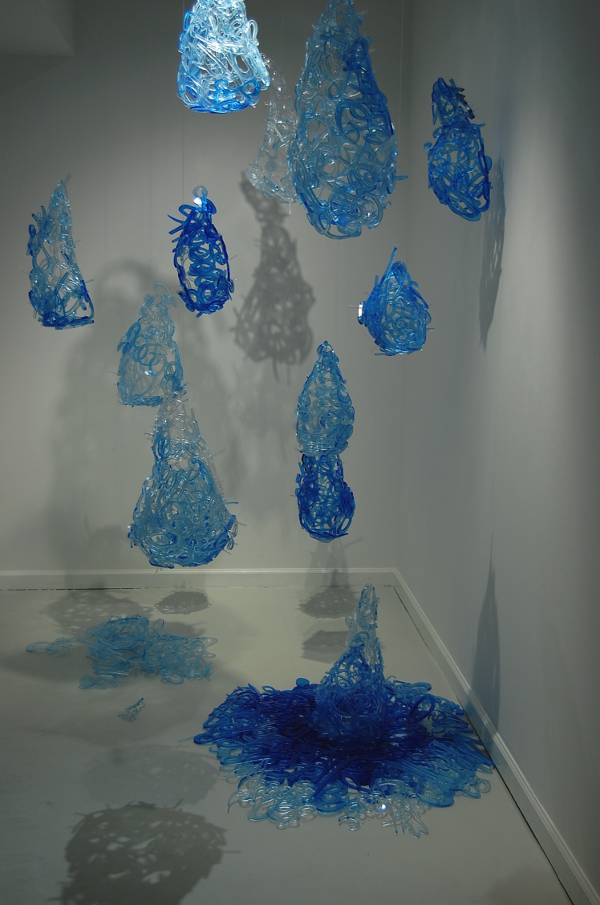
Gestures tie together opposing abstractions at Pentimenti
At Pentimenti Gallery through September, it is possible to stand on the border between two very contrasting bodies of abstract work. The sculptural and textual explorations of Simeen Farhat in “Logical Thinking; Illogical Thoughts” explode with translucent shapes and bristle with characters and words in a jumble of information, whereas Franco Mueller in “Transferable Views” presents a series of landscapes with sweeping brushstrokes that invoke the scenery glimpsed from a quickly passing car or train.
It is fairly apparent when looking at the mounted objects assembled by Farhat that we are not merely looking at relief sculptures, but also a form of poetry or literature. The pieces of poured resin seem to swirl with the movement of the script that forms them, as curved letters twist around phrases and written ideas, and jut out into the surrounding, empty air. While the features of these layered linguistic experiments are visually stunning, it is worth noting the literal subtext behind the structure. Despite the fact each of these individual artworks is composed of verbose cavalcades of symbols, their arrangement renders them all but indecipherable. In this way, they are a contradiction of both wordiness and silence as they remain frozen and still on the gallery walls.
Simeen Farhat, “Weeping Metaphors.”
One of the major texts that informs Farhat’s work is “Alice’s Adventures in Wonderland” by Lewis Carroll. In the back Project Room of Pentimenti, we find enormous blue droplets falling down from the ceiling and splashing apart on the floor. This installation entitled “Weeping Metaphors” is meant to directly reference the part of Carroll’s story in which Alice is transformed into a giant, and begins to cry equally gigantic tears. Elsewhere, two colorful crescents mimic the smile of the infamous Cheshire Cat. This ‘grin without a cat’ metaphor is in a way suggestive of Farhat’s entire body of work. Although it is clear that there is a deep cultural pool from which these pieces are derived, we cannot see the big picture – in this case the original writing in question – and are left with only the smirking edifice of the verbal contours instead of the whole cat.
Simeen Farhat, “Grin (Orange)” and “Grin (Blue).”
Unlike the surplus of content provided by Farhat, Franco Mueller tends to reduce whole places to scratches of acrylic paint and charcoal. One set of paintings consists of a distinct palette of blues, yellows, and their blended accompaniment of greenish hues. Many of these landscapes are barren, or at least featureless the way that lush farmland might blur into fields of color from the window of a moving train. Others have definite forms that seem like distant warehouses or box trucks, but the only characteristic that truly remains present in every image is Mueller’s dramatic brushwork. His hand is the most powerful element in every piece, with individual bristle marks visible in some swaths of paint, and the motion of his body almost palpable even in the clear absence of any figurative portrayals.
Two landscapes by Franco Mueller.
Facing these blue-green scenes is a series of five larger, black and white renderings which utilize both acrylic and charcoal. Each of this group resembles a sort of urban setting of concrete and columns as opposed to the more lush images across the way. They still contain a fair amount of movement, but the bulky buildings and bridges generally take up much more of the frame, with the flat land becoming subservient to the silhouettes of industry and transportation. The motion here even seems somewhat impeded by these monoliths, with the exception of one painting “Landscape #3,” in which the curling streaks of charcoal resemble smoke more than either buildings or open land. This piece is possibly the singular most abstract piece in the show, and although modest, it stands out for this reason alone.
Franco Mueller, “Landscape #3.”
Visiting Pentimenti right now allows us to see two artists working in very energetic ways with extremely dissimilar mediums and processes. Although the means and the ends occupy nearly opposite realms of the creative spectrum, it is interesting to see where both bodies of work share some characteristics – in their movements, gestures, layers, and tendency toward obscuring instead of revealing. Each show will be on display through September 28.
Pentimenti Gallery is located at 145 North 2nd St., Philadelphia; [email protected]; pentimenti.com.
Recent Content
-
Artsarticle ·
-
Artsarticle ·
-
Artsarticle ·




